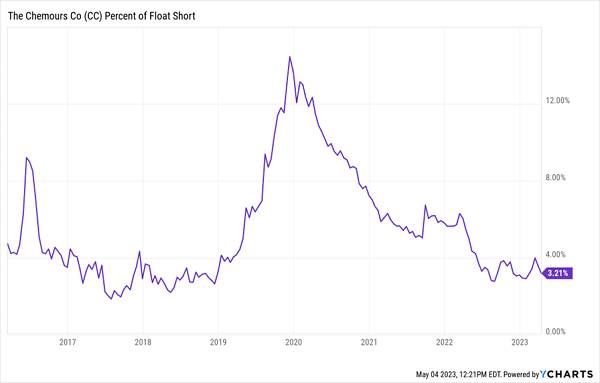Let’s dive into two simple indicators that can tell us when a dividend stock is set to lurch higher. Once we’re through, I’m certain you’ll wonder why you never thought of them before.
Last time we tried them, in my Contrarian Income Report advisory, they delivered a quick 90% return (more on that below). And we’ve got another nice setup to put them to work again.
Short Selling Is Back in the News—But We Take a Different Approach
First up, short selling—a phrase that strikes fear into most dividend investors’ hearts, for a couple of (good!) reasons. The main one being that selling short (or selling a stock you’ve borrowed in hopes of buying it back later at a lower price) can expose you to infinite losses, for a simple reason: share prices can theoretically rise without limit.
That’s pretty much the worst thing that can happen to you in investing—even worse than a stock going to zero!
Second, short selling does the opposite of what we want, because instead of collecting dividends, we’re forced to pay them on stocks we’ve “shorted.” Not good.
So no, we’re not going to short stocks ourselves, though we do tip our hats to the brave souls who’ve made themselves some nice “bank” by shorting regional banks like doomed PacWest Bancorp (PACW)—whose “float” was an astounding 26% short at last check—these last few weeks.
So what’s our play here?
Since short sellers tend to be wrong most of the time (fact!), we’re going to take the other side of the bet by buying stocks—or going “long” in Wall Street–speak—with high short interest (I like to see at least 10% of the float sold short). Then we’ll hang on as the price rises and shorts are forced to buy back the stock, driving the share price higher as they do.
This is a “short squeeze”—and it can be very profitable indeed. The classic example is the legendary short squeeze back in ’08 that sent shares of Volkswagen AG (OTC:VWAGY) soaring 82% in a single day. And you’ve no doubt seen a short squeeze in action if you followed the wild action around GameStop (NYSE:GME) and other so-called “meme stocks” a couple years back.
But how do we know they’ll be wrong? Simple—and this is where our second indicator comes in: we’re going to combine high short interest with another often misunderstood indicator—high insider buying.
When Insiders and Short Sellers Face Off, Insiders Win
As the great Peter Lynch wrote, insiders may sell for any number of reasons, but they only buy for one: they think the price will go up. (I’d add a second: they think the dividend will rise!)
I don’t know about you, but I’ll take the view of a corporate exec with their own cash on the line and their finger on the pulse of a company over a short seller looking to gamble.
How We “Played” Insiders Against Short Sellers—and Bagged a 90% Return
You can see this two-pronged strategy in action with chemical maker Chemours Co. (CC), which we bought in Contrarian Income Report in June 2020. Back then, CC yielded an outsized 7.4%.
At the time, short sellers were buzzing around the company because it was facing pending litigation. By June 2020, the number of Chemours shares sold short floated above my 10% “take notice” line. And remember, too, that these “shorts” had to pay the company’s fat dividend out of their own pockets!
That alone put a lot of pressure on them to throw in the towel—and that pressure formed Part 1 of our buy case. We weren’t done.
Short Sellers Bet Big on CC …
We then checked in on the C-suite, where Mark Newman, then-COO of the company (and now its president and CEO), had bought 2,500 CC shares in May 2020, bringing his total stake to around $1.9 million worth at the time.
Mark’s move caught our attention because based on his experience—he had been with the company since it was spun off from Dupont De Nemours Inc (NYSE:DD) in 2015—he had a good sense of the company’s chances in court. He was clearly bullish.
So were we. Here’s how things played out over our 16-month holding period:
… Then Surrender, Driving Our Gains
Sure enough, as it became clear that the shorts were wrong, they threw in the towel, buying back CC stock to cover their positions. And each share they repurchased pushed CC higher. We walked off with a 90% total return and collected that nice 7.4% payout the entire time.
Note, too, that the return of the shorts (on the right side of the chart above) gave us our cue to step to the side in October 2021. That worked in our favor, too, as we got out just before the 2022 dumpster fire and sidestepped the 5.5% decline in CC shares since.
Disclosure: Brett Owens and Michael Foster are contrarian income investors who look for undervalued stocks/funds across the U.S. markets. Click here to learn how to profit from their strategies in the latest report, "7 Great Dividend Growth Stocks for a Secure Retirement."
